Everybody knows the ‘↑Alien‘ (Scott 1979), but hardly anybody knows the actor behind the creature, Nigerian-born Bolaji Badejo. Above you can see him practicing on set—his movements remind me of ↑Max Schreck‘s performance in ‘↑Nosferatu‘ (Murnau 1922) and in consequence of Willem Dafoe in ‘↑Shadow of the Vampire‘ (Merhige 2000), an absolute must-see. By the way, in autumn 1979 the magazine Cinefantastique did an ↑interview with Bolaji Badejo.
what is guarded?
zeph’s pop culture quiz #35
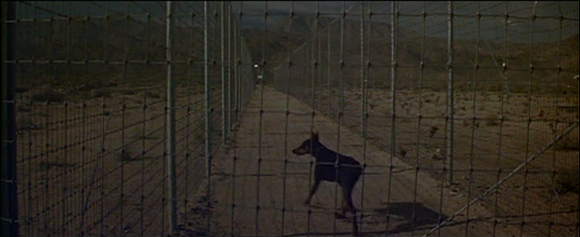
What is guarded by the watchdog?
Just leave a comment with your educated guess—you can ask for additional hints, too. [Leaving a comment is easy; just click the ‘Leave a comment’ at the end of the post and fill in the form. If it’s the first time you post a comment, it will be held for moderation. But I am constantly checking, and once I’ve approved a comment, your next ones won’t be held, but published immediately by the system.]
UPDATE and solution (05 July 2012):
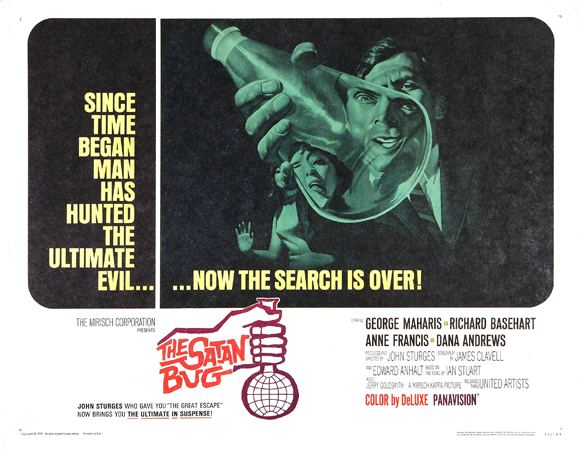
All right, this one was perfectly within ↑Kueperpunk‘s turf and ↵he recognized ‘↑The Satan Bug‘ (Sturges 1965) on first glance. The movie, starring ↑Anne Francis of ‘↑Forbidden Planet‘ (Wilcox 1965) fame, is a man-made infectious desease drama. The watchdog depicted above guards ‘Station Three’ a top-secrect government-run bioweapons laboratory located in southern California and housing, among other goodies, the Satan Bug itself.
what is spilled?
zeph’s pop culture quiz #34
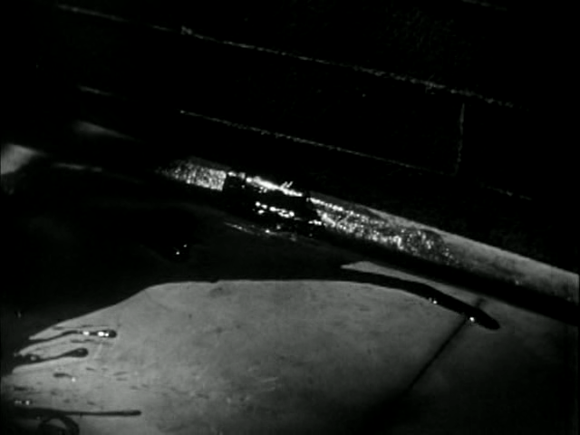
What kind of liquid is spilled on that floor?
Just leave a comment with your educated guess—you can ask for additional hints, too. [Leaving a comment is easy; just click the ‘Leave a comment’ at the end of the post and fill in the form. If it’s the first time you post a comment, it will be held for moderation. But I am constantly checking, and once I’ve approved a comment, your next ones won’t be held, but published immediately by the system.]
UPDATE (05 July 2012):
Meanwhile Alexander Rabitsch ↵correctly guessed that wine was spilled, but the movie isn’t ‘Three Strangers’ (Negulesco 1946) as he assumed (but he got damn close). Because of that here’s another screencap—the scene leading up to the spilling of wine:
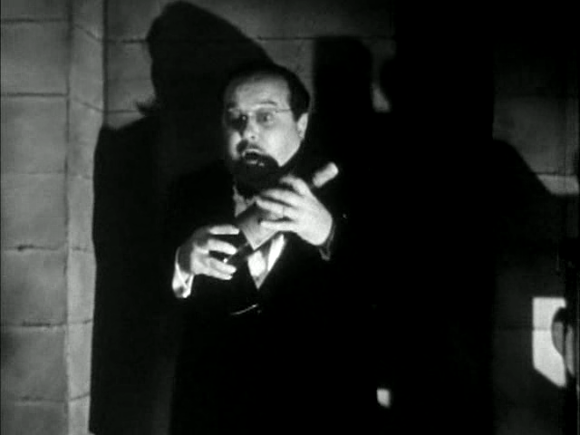
buddha and jesus
… ↑more of it.
what is searched?
zeph’s pop culture quiz #33

What are those two hands searching for in the drawer?
Just leave a comment with your educated guess—you can ask for additional hints, too. [Leaving a comment is easy; just click the ‘Leave a comment’ at the end of the post and fill in the form. If it’s the first time you post a comment, it will be held for moderation. But I am constantly checking, and once I’ve approved a comment, your next ones won’t be held, but published immediately by the system.]
star wars 1313
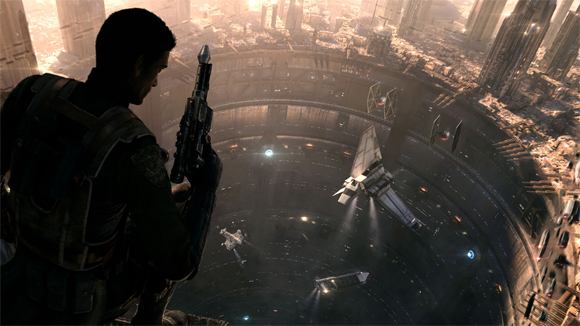
Somewhen I read a quote by George Lucas which I can’t find again—little wonder in the face of the tons of quotes of him published. It might have been in connection to the ephemeral sequel trilogy or the then upcoming ‘The Clone Wars.’ Anyway, if I remember correctly he stated that he wanted further material in the franchise to follow darker, grittier storylines. Immediately I thought that finally ‘the ↵mellow fairy tale mythology of this space operas disguised as science fiction’ are subjected to the cyberpunk discourse, too. Well, now it indeed may happen—at E3 LucasArts demonstrated a new Star Wars game called ‘↑Star Wars: 1313.’ Hothardware’s Joel Hruska ↑knows:
The 1313 moniker refers to a specific level of Coruscant that’s a haven for criminals, bounty hunters, and crime lords. You take on the role of a bounty hunter looking for information on an unspecified criminal conspiracy who descends to 1313 in search of data. This will be the first Star Wars game to be rated “M” for mature, and it focuses on the seedy underbelly of the universe. That decision alone could open up a wealth of gaming experiences. To date, we’ve only seen flashes of the poverty and desperation that exists within the Star Wars timeline; the games and movies may take quick trips to places like Nar Shadaa or the slums of Mos Espa, but these have always been pit stops on the way to glittering skyscrapers and grand cathedral-like buildings.
Kotaku carries some ↑concept art of 1313 … and ↵again I am reminded of ↵Jean ‘Mœbius’ Giraud‘s visionary artwork in the seminal ↑Incal series and sense the ↵french connection. Compare the 1313-screenshot above with the panels from ‘L’Incal noir’ (Jodorowsky & Mœbius 1981) below. Both are taken from near the end of the first album of the series. They finally reveal to the reader that the vast metropolis, within most of the plot took place till now, is underground, located inside a huge shaft. The first one (Jodorowsky & Mœbius 1981: 48) shows the presidential ship arriving at the city-shaft’s surface opening. Heavy fighting is going on in the city, hence the smoke and missile trajectories. In the second one (Jodorowsky & Mœbius 1981: 50) the ship nearly has landed and sealed the shaft. Through the narrow gap still open the ↑Meta-Baron makes his escape, his airplane soaring into the skies.
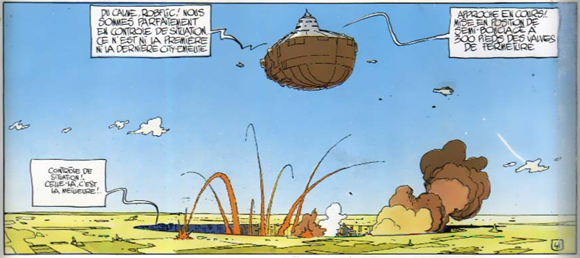
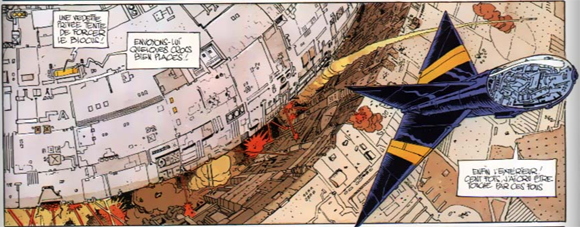
relational reality revisited
Having ↵mentioned Alex ‘↑Rex‘ ↑Golub‘s ‘↓Being in the World (of Warcraft)‘ (2010), I allow myself to point you to my ‘The Stability of Cyberspace’ which I first presented at the Cyberspace 2005 International Conference, and which subsequently was published in the conference’s proceedings (2006).
In order to grapple with the problem of reality, Rex draws on ↑Alfred Schütz and ↑William James (Golub 2010: 24, 33, 39, 40)—the same choice I made in ‘↓The Stability of Cyberspace‘ [just uploaded the thing for your convenience]—here is the, somewhat preposterous, abstract:
The lack of a suitable understanding of reality experienced by human beings hampers the discourse on social and cultural phenoma triggered by information and communication technologies (ICTs). This lack generates misunderstandings which accumulate in the notion of ICT-induced realms as a Gegenwelt, either in the form of an utopia or dystopia. The majority of the studies so far on the subject suffer from an utter lack of clarity of the discourse’s ever-resurfacing core-concepts “virtual reality” (VR), “cyberspace”, and “virtual community”. In fact, throughout the literature a shared understanding of these concepts does not exist.
From a sociocultural anthropological background this article provides a model of the experience of reality, which is based upon the works of Wil-liam James and Alfred Schütz, and thereby bridges the divide between positivism/materialism and constructivism. By combining this pragmatic model with the history of the above-mentioned concepts, a sound basis for research on ICT-induced phenomena is generated.
Behind ‘The Stability of Cyberspace’ looms a longer, never-published article called ‘↓Virtualism and the Stability of Cyberspace‘ (2004) [uploaded that one, too] which I just found again while looking into the matter: In 2005, when Rex Golub was deeply into the World of Warcraft, he had posted an ↑entry on William James at [the now defunct] digitalgenres.org. After that we threw emails to and fro and I sent him that longer version about which I had forgotten till a minute ago.
Matter of fact is that for both texts I heavily drew on a portion of my doctoral dissertation ‘↓Metatrickster‘ (2004)—its 18th chapter, ‘Neohermeticon’ (Knorr 2004: 253-269), discusses and develops the idea of the ‘stability of reality’ in-depth, without the integral reference to the online realms. For those interested, and capable of reading German: you can ↓download ‘Metatrickster’ in full and for free [if you are interested in a printed copy, drop me a line].
engine john’s goggles
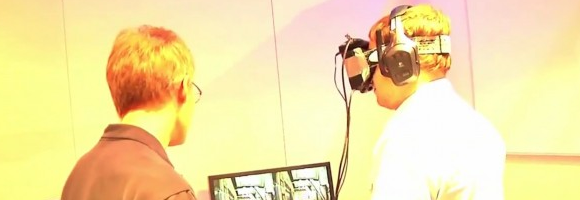
John Carmack, on the left, demonstrating a prototype of his VR goggles to PCGamer’s David Boddington at E3 2012
Just last week I had my students discuss in class Alex ‘↑Rex‘ ↑Golub‘s excellent ethnography-based article ‘↓Being in the World (of Warcraft)‘ (2010). One of the points Rex powerfully makes is that it isn’t ever more realistic (or: naturalistic) graphics and supposedly intuitive interfaces that guarantee deep immersion into computer games and so-called ‘virtual worlds,’ but social relationships (a point that I do second fully). Hence the vision of ↑VR pioneers/evangelists like ↑Jaron Lanier and the prospects fostered by cyberpunk were somewhat misleading:
No sooner had text only worlds blossomed before it appeared they would be replaced by immersive “virtual realities,” which would produce qualia as realistic as those experienced in the actual world. Envisioned first in science fiction classics such as True Names (Vinge 1981), Neuromancer (Gibson 1984), and Snowcrash (Stephenson 1992), the idea of sensorially realistic virtual worlds grew in popularity in the early nineties as authors such as Howard Rheingold popularized emergent technologies which seemed to promise the imminent feasibility of their construction (Rheingold 1992).
By the late nineties, however, the development of haptic interfaces and virtual reality goggles sputtered out, and it became increasingly clear that science fiction’s vision of a future world littered with virtual realities would not come to pass. At the same time, the rise of the Internet and the blogs, wikis, and social network sites it supported indicated that “cyberspace is necessarily a multiple-participant environment” and “the almost mystical euphoria” that surrounded “DataGloves, head-mounted displays, special-purpose rendering engines” was “both excessive and misplaced” (Morningstar and Farmer 1991). Relationships, not realism, seemed to be central to future technologies. Rheingold himself concurred. In his 2003 review of emerging technologies, he admitted that “the past ten years of VR have not been as exciting as the original idea was or as I had thought they would be” (Rheingold 2003:89). Rather, the “world of the twenty-first century” would be one in which “computers would be built into reality rather than the other way around” (Rheingold 2003:82) via technologies such as ubiquitous and tangible computing and mobile telephony. “Science fiction has disserved us,” wrote Philip Agre presciently. “Gibson famously defined cyberspace as a space apart from the corporeal world—a hallucination. But the Internet is not growing apart from the world, but to the contrary is increasingly embedded in it” (Agre 1999). Realistic, separated virtual worlds were off the menu. (Golub 2010: 20-21)
But now ↑John Carmack is making a virtual reality headset. If Engine John himself is at it, it might well be that the VR goggles, that archetypical cyberpunk gadget, makes a comeback. Here’s a snippet from PD102’s comment:
‘And here is Carmack basically building the start of his Iron Man suit. Virtual Reality though, if anyone can make it work. It’s Carmack.’ Followed by neros1x’s:
‘2000 years from now, atheists will be arguing that John Carmack didn’t REALLY ascend to heaven to sit at the right hand of god.’
difference engine day

From the ↑Charles Babbage biography at ↑The MacTutor History of Mathematics archive (University of St Andrews, Scotland):
Babbage is without doubt the originator of the concepts behind the present day computer. The computation of logarithms had made him aware of the inaccuracy of human calculation around 1812. He wrote in [C Babbage, Passages from the life of a philosopher (London, 1864).]:-
… I was sitting in the rooms of the Analytical Society, at Cambridge, my head leaning forward on the table in a kind of dreamy mood, with a table of logarithms lying open before me. Another member, coming into the room, and seeing me half asleep, called out, Well, Babbage, what are you dreaming about?” to which I replied “I am thinking that all these tables” (pointing to the logarithms) “might be calculated by machinery.”
Certainly Babbage did not follow up this idea at that time but in 1819, when his interests were turning towards astronomical instruments, his ideas became more precise and he formulated a plan to construct tables using the method of differences by mechanical means. Such a machine would be able to carry out complex operations using only the mechanism for addition. Babbage began to construct a small difference engine in 1819 and had completed it by 1822. He announced his invention in a paper Note on the application of machinery to the computation of astronomical and mathematical tables read to the Royal Astronomical Society on 14 June 1822.
portal terminal velocity
via ↑entry at ↑boingboing

